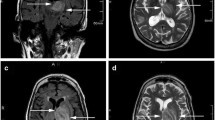Abstract
Balamuthia mandrillaris is an emerging cause of subacute granulomatous amebic encephalitis (GAE). The diagnosis of this infection has proven to be difficult and is usually made postmortem. Early recognition and treatment may offer some benefit. This report describes a previously healthy woman who died from GAE due to B. mandrillaris.



Similar content being viewed by others
References
Ahmad AF, Andrew PW, Kilvington S (2011) Development of a nested PCR for environmental detection of the pathogenic free-living amoeba Balamuthia mandrillaris. J Eukaryot Microbiol 58:269–271
CDC (2008) Balamuthia amebic encephalitis-California. 1999–2007. MMWR 57:768–771
CDC (2010) Balamuthia mandrillaris transmitted through organ transplantation – Mississippi −2009. MMWR 59:1165–1170
CDC (2013) Investigational drug available directly from CDC for the treatment of infections with free-living amebae. Morbidity and Mortality Weekly Report (MMWR) 62(33):666–666
Cope JR, Roy SL, Yoder JS, Beach MJ (2013) Improved treatment of granulomatous amebic encephalitis and other infections caused by Balamuthia mandrillaris and Acanthamoeba species [Poster]. Presented at Council of State and Territorial Epidemiologists' Annual Conference, Pasadena, CA, 9–13 June 2013. Available at http://www.cste2.org/confpresentations/uploadedfiles/cste%202013%20miltefosine%20poster%20final.pdf
Deetz TR, Sawyer MH, Billman G, Schuster FL, Visvesvara GS (2003) Successful treatment of Balamuthia amoebic encephalitis: presentation of 2 cases. Clin Infect Dis 37:1304–1312
Doyle JS, Campbell E, Fuller A, Spelman DW, Cameron R, Malham G, Gin D, Lewin SR (2011) Balamuthia mandrillaris brain abscess successfully treated with complete surgical excision and prolonged combination antimicrobial therapy. J Neurosurg 114(2):458–462
Jayasekera S, Sissons J, Tucker J, Rogers C, Nolder D, Warhurst D, Alsam S, White JM, Higgin EM, Khan NA (2004) Postmortem culture of Balamuthia mandrillaris from the brain and cerebrospinal fluid of a case of granulomatous amoebic meningoencephalitis, using human brain microvascular epithelial cells. J Med Microbiol 53:1007–1012
Jung S, Schelper RL, Visvesvara GS, Chang HT (2004) Balamuthia mandrillaris meningoencephalitis in an immunocompetent patient: an unusual clinical course and a favorable outcome. Arch Pathol Lab Med 128:466–468
Kiderlen AF, Laube U (2004) Balamuthia mandrillaris, an opportunistic agent of encephalitis, infects the brain via the olfactory nerve pathway. Parasitol Res 94:49–52
Kiderlen AF, Laube U, Radam E, Tata PS (2007) Oral infection of immunocompetent and immunodeficient mice with Balamuthia mandrillaris amebae. Parasitol Res 100:775–782
Schuster FL, Visvesvara GS (2008) Balamuthia mandrillaris. In: Khan NA (ed) Emerging protozoan pathogens. Taylor and Francis Group, New York, pp pg71–pg118
Schuster FL, Dunnebacke TH, Booton GC, Yagi S, Kohlmeier CK, Glaser C, Vugia D, Bakardjiev A, Azimi P, Maddux-Gonzalez M, Martinez AJ, Visvesvara GS (2003) Environmental isolation of Balamuthia mandrillaris associated with a case of amebic encephalitis. J Clin Microbiol 41:3175.5–3180.5
Siddiqui R, Khan NA (2008) Balamuthia amoebic encephalitis: an emerging disease with fatal consequences. Microb Pathog 44:89–97
Visvesvara GS, Martinez AJ, Schuster FL, Leitch GJ, Wallace SV, Sawyer TK, Anderson M (1990) Leptomyxid ameba, a new agent of amebic meningoencephalitis in humans and animals. J Clin Microbiol 18(12):2750–2756
Visvesvara GS, Moura H, Schuster FL (2007) Pathogenic and opportunistic free-living amoebae: Acanthamoeba spp., Balamuthia mandrillaris, Naegleria fowleri, and Sappinia diploidea. FEMS Immunol Med Microbiol 50:1–26
Yagi S, Booton GC, Visvesvara GS, Schuster FL (2005) Detection of Balamuthia mitrochondrial 16S rRNA gene DNA in clinical specimens by PCR. J Clin Microbiol 43(7):3192–3197
Acknowledgments
We thank Gary P. Wormser, MD for reviewing this manuscript and for the expert technical help by R. Sriram.
Conflicts of interest
None
Author information
Authors and Affiliations
Corresponding author
Rights and permissions
About this article
Cite this article
Lobo, S.A., Patil, K., Jain, S. et al. Diagnostic challenges in Balamuthia mandrillaris infections. Parasitol Res 112, 4015–4019 (2013). https://doi.org/10.1007/s00436-013-3592-z
Received:
Accepted:
Published:
Issue Date:
DOI: https://doi.org/10.1007/s00436-013-3592-z




